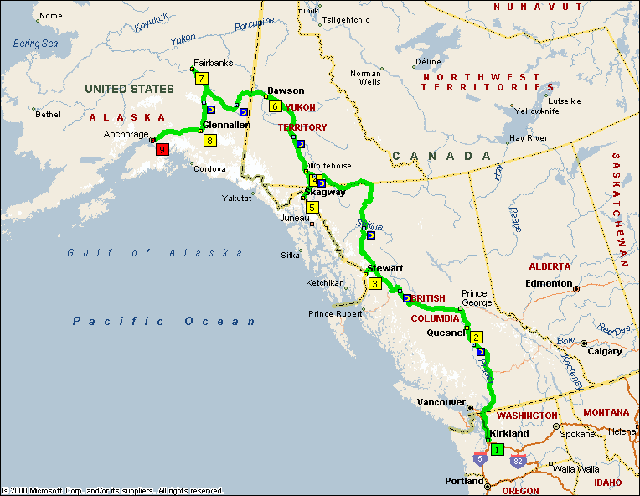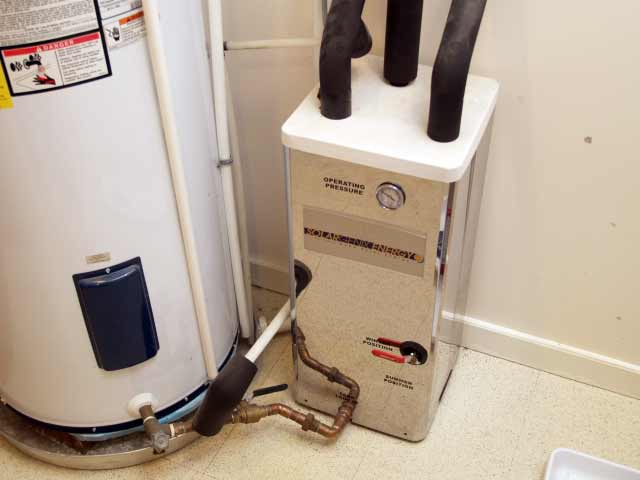2006 Alcan 5000 Route
I have worked up a simple representation of the 2006 Alcan 500 route. It does not show any of the "optional sections" such as the South or North Canol roads, etc.

« September 2005 | Main | March 2006 »
I have worked up a simple representation of the 2006 Alcan 500 route. It does not show any of the "optional sections" such as the South or North Canol roads, etc.

Here is a shot of the floor that covers the main living spaces of our home. They are a very smooth, flat brick that serves as a thermal mass. It really helps the house resist temperature swings. The floor is "tied" to the earth by a meticulously sealed crawlspace.
Part of what makes our house unique is our backup power system. Power outages around here are commonplace. You can count on the power going out whenever there is a thunder storm. Ice storms in the winter have the same effect, and the outages can last for days, even a week or more. What is odd, though, is that sometimes, the power will go out in the middle of a sunny day!

Instead of a gasoline or propane powered generator, which is what most homes that have backup power use around here, we have batteries and an inverter. The inverter is a Trace (now Xantrex) 4000 watt continuous sine wave model. It converts the 48 volt battery power to 120v AcC. It also keeps the batteries charged and in top shape. When the grid is up, the inverter gets the power it needs to keep the batteries charged from the grid. When the grid fails, the solar panels feed the batteries, through the inverter.

When the grid goes out, there is a little hiccup, while the inverter kicks in. It does not provide power to all of the circuits in the house, rather, the so-called critical Loads, such as the refrigerator, well pump, lights, the furnace blower, internet router, and of course, the TV. Not all of the lights are backed up, just some in each living area.
Since we moved in, we have not had to test the full capacity of the batteries, since the longest outage we have experienced was about 4-5 hours.
All of the wiz bang tech solar stuff that is not on our roof is in the utility room.

This is the Solargenix Hot water heat exchanger. It has a DC pump that is powered by its own solar panel on the roof. If it is sunny, the pump runs; if it is not, no pumping. The roof panels contain a glycol solution, which is pumps down into the heat exchanger, where the heat is transferred to water from the hot water heater in the picture. This is an ordinary domestic hot water heater which holds 80 gallons of water. In the summer months, the water in the tank can reach 160 degrees. A tempering valve brings it down to reasonable temps when it is called for at a fixture.
The tank has electric elements, which I like to turn off at the breaker. If we get a few days of very cloudy weather in a row, the water in the tank starts to get cooler. By keeping the element off whenever possible, we can get a sense of when we are using solar heated water, and when we are using electricity to supplement the system.
I have been meaning to write about our new home in North Carolina for same time, well, this is the first post to start this project.
In March of 2004, Getchen and I moved form Groton, MA to our new home
This is the first Solar Hybrid house build by John Delafield of Landmark Solar. We found the house through the net - we were already working through a Realtor, and I happened upon a post in the Chatham county web board by John. The house looked fantastic, but we were very interested in lowering our monthly housing expenses, and this would not be doing that. So I did not visit the home on one of my trips to NC, but we kept it in our minds. Gretchen and I would talk about it occasionally, and then I started to do some math. When I added up our current mortgage (literal translation: Death pledge) and utilites costs, and compared them to what I thought they would be wit the Solar house, the combined figure for the solar house was almost $600 less.
So we went to see the house. At this point, we had just put our house up for sale up in MA. Well, one visit, and we knew we wanted it. We called back and asked John to meet us, made an offer which he accepted, and here we are, almost two years later. So, about the house, why is a "Solar Hybrid House" Well, from the driveway, the "front" of the house which faces north, it looks like, well, it could be any house, anywhere, certainly not a Solar house. But go around to the back, the south side, and something you know you are not in Kansas anymore! It is a warm, comfortable home, and we are cutting greenhouse gasses we are responsible for by a large amount.
In a nutshell, the house features:
We were one of the first two homes to participate in theNC GreenPower Program. 100% of the power we generate while on-grid is sold first to Progress energy. They give us a paltry amount for the power, between 2-3 cents for each KWH. In addition, we have a second meter for this "Feed", which as a separate charge totaling $8.87 per month, which means we usually owe them money for the privilege fo giving them free electricity! It is not all bad though, as NC Greenpower pays us 18 cents for each kwh we produce.